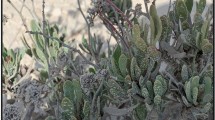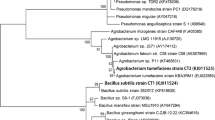Abstract
Twelve endophytic bacteria were isolated from the meristem of in vitro Cymbidium eburneum orchid, and screened according to indole yield quantified by colorimetric assay, in vitro phosphate solubilization, and potential for plant growth promotion under greenhouse conditions. Eight strains with positive results were classified into the genus Paenibacillus by FAME profile, and evaluated for their ability to increase survival and promote the growth of in vitro germinated Cattleya loddigesii seedlings during the acclimatization process. The obtained results showed that all strains produced detectable indole levels and did not exhibit potential for solubilizing inorganic phosphate. Particularly, an increase of the total biomass and number of leaves was observed. Two strains of Paenibacillus macerans promoted plant growth under greenhouse conditions. None of the treatments had a deleterious effect on growth of inoculated plants. These results suggest that these bacterial effects could be potentially useful to promote plant growth during seedling acclimatization in orchid species other than the species of origin.

Similar content being viewed by others
References
Araújo WL, Marcon J, Maccheroni Junior W, van Elsas JD, van Vuurde JWL, Azevedo JL (2002) Diversity of endophytic bacterial populations and their interaction with Xylella fastidiosa in citrus plants. Appl Environ Microbiol 68:4906–4914
Arditti J, Ernst R (1993) Micropropagation of orchids. Wiley, New York
Bayman P, González EJ, Fumero JJ, Tremblay RL (2002) Are fungi necessary? How fungicides affect growth and survival of the orchid Lepanthes rupestris in the field. J Ecol 90:1002–1008
Bertaux J, Schmid M, Prevost-Boure NC, Churin JL, Hartmann A, Garbaye J, Frey-Klett P (2003) In situ identification of intracellular bacteria related to Paenibacillus spp. in the mycelium of the ectomycorrhizal fungus Laccaria bicolor S238N. Appl Environ Microbiol 69:4243–4248
Chugh S, Guha S, Usha RI (2009) Micropropagation of orchids: a review on the potential of different explants. Sci Hortic 122:507–520
Chutima R, Dell B, Vessabutr S, Bussaban B, Lumyong S (2011) Endophytic fungi from Pecteilis susannae (L.) Rafin (Orchidaceae), a threatened terrestrial orchid in Thailand. Mycorrhiza 21:221–229
Costa FEC, Melo IS (2012) Endophytic and rhizospheric bacteria from Opuntia ficus-indica mill and their ability to promote plant growth in cowpea, Vigna unguiculata (L.) Walp. Afr J Microbiol Res 6:1345–1353
De Boer W, Folman LB, Summerbell RC, Boddy L (2005) Living in a fungal world: impact of fungi on soil bacterial niche development. FEMS Microbiol Rev 29:795–811
Dearnaley J (2007) Further advances in orchid mycorrhizal research. Mycorrhiza 17:475–486
Dias ACF, Costa FEC, Andreote FD, Lacava PT, Teixeira MA, Assumpção LC, Araújo WL, Azevedo JL, Melo IS (2009) Isolation of micropropagated strawberry endophytic bacteria and assessment of their potential for plant growth promotion. World J Microbiol Biotech 25:189–195
Erturk Y, Ercisli S, Haznedar A, Cakmakci R (2010) Effects of plant growth promoting rhizobacteria (PGPR) on rooting and root growth of kiwifruit (Actinidia deliciosa) stem cuttings. Biol Res 43:91–98
Erturk Y, Ercisli S, Cakmakci R (2012) Yield and growth response of strawberry to plant growth-promoting rhizobacteria inoculation. J Plant Nutr 35:817–826
Galdiano RF Jr, Pedrinho EAN, Castellane TCL, Lemos EGM (2011) Auxin-producing bacteria isolated from the roots of Cattleya walkeriana, an endangered brazilian orchid, and their role in acclimatization. R Bras Ci Solo 35:729–737
Gordon SA, Weber RP (1951) Colorimetric estimation of indole acetic acid. Plant Physiol 26:192–195
Guerra MP, Torres AC, Teixeira JB (1999) Embriogênese somática e sementes sintéticas. In: Torres AC, Caldas LS, Buso JA (eds) Cultura de tecidos e transformação genética de plantas, vol 20. Embrapa-SPI/Embrapa-CNPH, Brasília, pp 533–568
He L, Zhang P, Sun L (2011) Isolation and Identification of the endophyte bacteria from Coreopsis lanceolata L. Hubei Agric Sci 5:102–103
Heyndrickx M, Vandemeulebroecke K, Hoste B, Janssen P, Kersters K, De Vos P, Logan NA, Ali N, Berkeley RC (1996) Reclassification of Paenibacillus (formerly Bacillus) pulvifaciens (Nakamura 1984) Ash et al. 1994, a later subjective synonym of Paenibacillus (formely Bacillus) larvae (White 1906) Ash et al. 1994, as a subspecies of P. larvae, with emended descriptions of P. larvae as P. larvae subsp. larvae and P. larvae subsp. pulvifaciens. Int J Sys Bacteriol 46:270–279
Hoffman MT, Arnold AE (2010) Diverse bacteria inhabit living hyphae of phylogenetically diverse fungal endophytes. Appl Environ Microbiol 76:4063–4075
Kidoglu F, Gul A, Ozaktan H, Tuzel Y (2007) Effect of rhizobacteria on plant growth of different vegetables. ISHS acta horticulturae, 801: international symposium on high technology for greenhouse system management: Greensys 2007
Kobayashi DY, Palumbo JD (2000) Bacterial endophytes and their effects on plants and uses in agriculture. In: Bacon CW, White JF (eds) Microbial endophytes. Dekker, New York, pp 199–236
Kolomeitseva G, Tsavkelova E, Gusev E, Red’ko N, Cherdyntseva T, Netrusov A (2006) Bacterial strain Bacillus pumillus KM MGU 467 stimulating the germination of the orchid seeds, and the mode of its application. Patent of Russian Federation No. 2272409 with priority of 09.03.04. In Patent’s Bulletin 0609 of 27.03.06
Kulkarni AA, Kelkar SM, Watve MG, Krishnamurthy KV (2007) Characterization and control of endophytic bacterial contaminants in in vitro cultures of Piper spp., Taxus baccata subsp. wallichiana, and Withania somnifera. Can J Microbiol 53:63–74
Malboodi MA, Behbahani M, Madani H, Owlia P, Deljou A, Yakhchali B, Moradi M, Hassanabadi H (2009) Performance evaluation of potent phosphate solubilizing bacteria in potato rhizosphere. World J Microbiol Biotechnol (ONLINE). doi:10.1007/s11274-009-0038-y
Murashige T, Skoog F (1962) A revised medium for rapid growth and bioassays with tobacco tissue cultures. Physiol Plant 15:473–497
Nautiyal CS (1999) An efficient microbiological growth medium for screening phosphate solubilizing microorganisms. FEMS Microbiol Lett 170:265–270
Otero TJ, Ackerman JD, Bayman P (2002) Diversity and host specificity of endophytic Rhizoctonia-like fungi from tropical orchids. Am J Bot 89:1852–1858
Phi QT, Yu-Mi P, Keyung-Jo S, Choong-Min R, Seung-Hwan P, Jong-Guk K, Sa-Youl G (2010) Assessment of root-associated Paenibacillus polymyxa groups on growth promotion and induced systemic resistance in pepper. J Microbiol Biotechnol 20:1605–1613
Pikovskaya RI (1948) Mobilization of phosphorus in soil in connection with the vital activity of some microbial species. Mikrobiologiya 17:362–370
Seidel Junior D, Venturieri GA (2011) Ex vitro acclimatization of Cattleya forbesii and Laelia purpurata seedlings in a selection of substrates. Acta Sci Agron 33:97–103
Sharma M, Schmid M, Royhballer M, Hause G, Zuccaro A, Imani J, Kampfer P, Domann E, Schafer P, Hartmann A, Kogel KH (2008) Detection and identification of bacteria intimately associated with fungi of the order Sebacinales. Cell Microbiol 10:2235–2246
Srivastava OS, Bharti N, Pandey D et al (2002) Role of mycorrhiza in in vitro micropropagation of plants. In: Mukerji KG, Manoharachari C, Chamola BP (eds) Techniques in mycorrhizal studies. Kluwer, The Netherlands, pp 443–460
Sun L, Bi X, Li L, Liu L, Han J, Yang K (2009) Primary research on the isolation method of root endophytic bacteria of Cymbidium goeringii. J Agric Univ Hebei 32:42–46
Tan XM, Chen XM, Wang CL, Jin XH, Cui JL, Chen J, Guo SX, Zhao LF (2012) Isolation and identification of endophytic fungi in roots of nine Holcoglossum plants (Orchidaceae) collected from Yunnan, Guangxi, and Hainan provinces of China. Curr Microbiol 64:140–147
Teixeira DA, Alfenas AC, Mafia RG, Ferreira EM, Siqueira LD, Luiz A, Maffia LA, Mounteer AH (2007) Rhizobacterial promotion of eucalypt rooting and growth. Braz J Microbiol 38:118–123
Trivedi P, Pandey A (2007) Biological hardening of micropropagated Picrorhiza kurrooa Royel ex Benth., an endangered species of medical importance. World J Microbiol Biotechnol 23:877–878
Tsavkelova EA, Yu Klimova S, Cherdyntseva TA, Netrusov AI (2006) Microbial producers of plant growth stimulators and their practical use: a review. Appl Biochem Microbiol 42:117–126
Tsavkelova EA, Cherdyntseva TA, Klimova SY, Shestakov AI, Botina SG, Netrusov AI (2007a) Orchid-associated bacteria produce indole-3-acetic acid, promote seed germination, and increase their microbial yield in response to exogenous auxin. Arch Microbiol 188:655–664
Tsavkelova EA, Cherdyntseva TA, Botina SG, Netrusov AI (2007b) Bacteria associated with orchid roots and microbial production of auxin. Microbiol Res 162:69–76
Vendramin E, Gastaldo A, Tondello A, Baldan B, Villani M, Squartini A (2010) Identification of two fungal endophytes associated with the endangered orchid Orchis militaris L. J Microbiol Biotechnol 2:630–636
Wilkinson KG, Dixon KW, Sivasithamparam K (1989) Interaction of soil bacteria, mycorrhizal fungi and orchid seed in relation to germination of Australian orchids. New Phytol 112:429–435
Wilkinson KG, Sivasithamparam K, Dixon KW, Fahy PC, Bradley JK (1994) Identification and characterisation of bacteria associated with Western Australian orchids. Soil Biol Biochem 26:137–142
Wimber DE (1963) Clonal multiplication of cymbidium trough tissue culture of the shoot meristem. Am Orch Soc Bull 32:105–107
Zhang P, Song X (2012) Advances in diversity and promotion mechanism of endophytic bacteria associated with orchids. J Trop Subtrop Bot 20:92–98
Acknowledgments
This study was supported by a grant from the State of São Paulo Research Foundation (FAPESP/BIOTA 2004/13910-6) and A.C.F. Dias (2008/54013-8) received a graduate fellowship.
Author information
Authors and Affiliations
Corresponding author
Rights and permissions
About this article
Cite this article
Faria, D.C., Dias, A.C.F., Melo, I.S. et al. Endophytic bacteria isolated from orchid and their potential to promote plant growth. World J Microbiol Biotechnol 29, 217–221 (2013). https://doi.org/10.1007/s11274-012-1173-4
Received:
Accepted:
Published:
Issue Date:
DOI: https://doi.org/10.1007/s11274-012-1173-4




